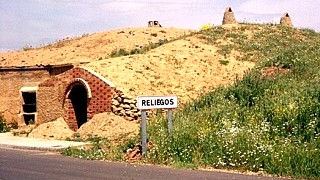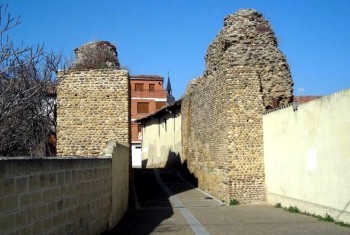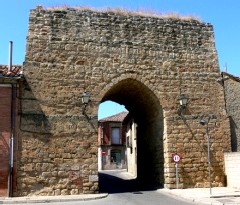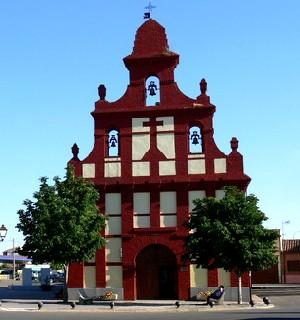Camino de Santiago - French Way - Stage 20 - El Burgo Ranero to Mansilla de las Mulas
Total distance: 19 km
As mentioned in the last stage of our journey we are taking the Camino Real Francés between Sahajun and Mansilla de las Mulas. At the bottom of this page we will give details of the alternative route along the original Camino la Calzada de los Peregrinos.
To leave El Burgo Ranero follow the main road through the village past the church and then past the cemetery. Walk for approximately 4.5 kilometres and you will come across a brick fountain set back slightly from the road in amongst some trees. Keeping straight on after another 3.5 kilometres you pass a turning that takes you to the village of Villamarco. The village is about 1 kilometre off the Camino but it does have all the usual amenities so if you feel like a detour then turn left here. If not continue on for another 2 kilometres at which point the route crosses the railway line.

From here we more or less follow the railway line, keeping it to our left for most of the next few kilometres. We soon enter a small valley crossing 2, usually dried up, rivers firstly the Valdearcos and then the Santa Maria. Soon after crossing the Santa Maria the landscape becomes a little hillier with wine storage cellars or bodegas set into the hills every now and then. 2 kilometres later we enter the village of Reliegos.

In Roman times Reliegos was an important transport centre as it lay at the coming together of three major roads. It's most recent claim to fame though is that of the last major meteorite strike to have hit Spain, way back at 8am on the 28th December 1948. The meteorite fell on the Calle Real and weighed around 8.9 kilos (19.621 pounds) and the crater it created was 35cm (13.78 inches) deep. Unfortunately you won't get to see the meteorite here in Reliegos as it was taken to the Museo Nacional de Ciencas Naturales in Madrid.
The large municipal albergue is quite modern and has both cooking facilities and internet access. There are some cafés around the main square and a shop to stock up on provisions.
Leave Reliegos by walking straight through the village and joining a stony track and your next stop, Mansilla de las Mulas, can be seen approximately 6 kilometres away. The path is more or less straight from here until you reach the main road. Cross over the road, then walk over the bridge spanning the canal and enter the town of Mansilla de las Mulas. Whether you have walked the Camino Real Francés or the alternative Calzada de los Peregrinos here is where both Caminos meet.

You enter Mansilla de las Mulas through the medieval Puerta del Castillo and down the Calle Santa Maria into the Plaza del Pozo where you will find a number of rather good pastelerias for those of you with a sweet tooth.
The name of the town comes from the Spanish for hand (mano) and saddle (silla de montar). The town's coat of arms depicts a hand resting on a saddle. The Mulas (mules) part of the town's name refers to the ancient mule markets that took place here.

The 14 metre high walls that surround Mansillas de las Mulas are believed to have been built some time in the 12th century, though there may well have been some type of fortification here since Roman times. The walls originally had 4 gates, the gate from which you entered the town, la Puerta del Castillos was the main gate, the best preserved though is la Puerta de la Concepción. In some parts the walls are an impressive 3 metres thick. Worth seeing is the stretch of wall that runs alongside the Rio Esla.
At the height of the Camino's prominence during the Middle Ages Mansilla de las Mulas became a significant stopping point for the Pilgrims and once had 3 pilgrim hospitals, 2 convents and 7 churches. The 13th century Iglesia de Santa Maria and the Ermita de la Virgen de Gracia are the only remnants from these earlier times. The Iglesia de Santa Maria was the oldest church in the town having been the only one in the town up until 1220 when they started to build the others. The building that stands there now is from the 18th century but was built over the original.

The original Ermita de la Virgen de Gracia was built around the same time as the Iglesia de Santa Maria and like the church, the current building is from a later era, probably 14th century.
The Iglesia de San Martín, which was also built in 1220 has now become the Casa de Cultura, or cultural centre, of Mansilla de las Mulas. The only part of the original church remaining is the tower.
As promised I will give you the alternative route from Calzadilla de los Hermanillos, which was our last stop on the Calzada de los Peregrinos.
The route from here is pretty much a straight one all the way to Mansilla de Las Mulas, crossing an immense plateau with nothing to see but cornfields in every direction, and the occasional train. After about 3.5 kilometres the tarmacked track you have been following turns into an un-surfaced road which you follow for at least 13.5 kilometres and then, as if from nowhere, you come to a deserted railway station at Apeadero Villamarco. As per the other Camino the village of Villamarco is close by, approximately 2 kilometres to the south. If you are desperate to stop cross the railway line at this point. If not keep straight on walking more or less parallel to the railway line and after about 4 kilometres you begin to go through the valley with the two dried up rivers, the Valdearcos and then the Santa Maria. 6 kilometres further on you enter two more valleys where the path veers to the left. After a while you emerge from the second valley where you will come to a junction from where you will see the church tower of Reliegos.
The path leading to Reliegos is about 500 metres away and if you wish you can meet up with the Camino Real Francés here or alternatively if you want to keep on your original path, take a right down a track shortly after the junction and after approximately 6 kilometres you reach Mansilla de las Mulas.

